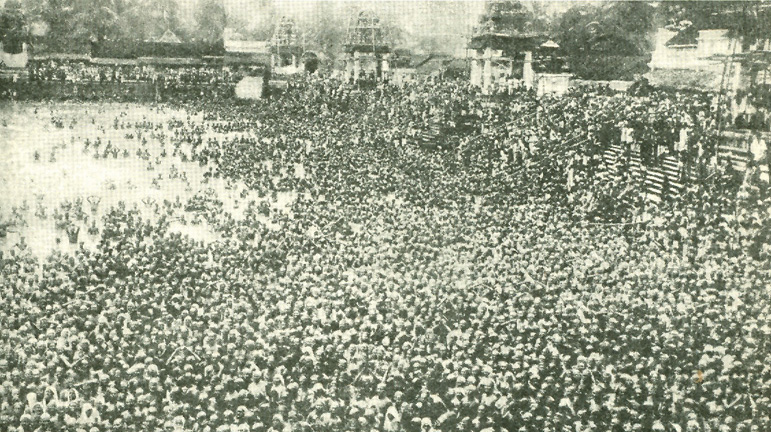
This picture takes you into the very heart of the story of India. It presents two of the most important aspects of that mysterious land—its crowded population and the powerful influence of its ancient religions. For here we see a dense throng of pilgrims bathing in the Ganges River near the city of Benares. From all parts of India they have come to wash away their sins in the "sacred waters." Back they wfll go, probably scattering broadcast the germs of plague and cholera. Before the conservatism of the East, Western civilization still stands almost helpless, unable to penetrate the ranks of this vast army of people, unable to teach them the laws of health or sway them from their age-old customs.
INDIA A land of fascinating and infinite variety is India, which thrusts 1,900 miles downwards from the Himalaya Mountains (into the Indian Ocean, and is inhabited by almost one-sixth of the human race, And what contrasts among these crowded people! They are divided into numerous races and clans; they speak more than 200 distinct languages and dialects; they profess countless shades of religious beliefs ; they are ;split into 2,300 different social castes; and they are grouped into more than 700 provinces and petty states. Despite their civilization reaching back 5,000 years, more than 90 per cent. of these people cannot read or write in any language. Some of the more powerful Indian princes, with their secret stores of gold and silver and precious stones, are among the most wealthy men in the world; yet unbelievable poverty reigns for the most part. Thousands die of starvation almost every year, and thousands more, weakened by hunger, fall victims to the plague.
A broad view of the country shows four separate and well-defined regions. The mountain and hill districts of the Himalayan ranges, and the slopes of the Afghanistan and Baluchistan highlands form the northern and northwestern borders. Then come the great river plains of the Indus, the Ganges, and the lower Brahmaputra, forming a broad belt from the head of the Arabian Sea to the head of the Bay of Bengal.
Next is the great tableland known as the Deccan, which includes the southern half of India; it is bounded by the range of hills known as the Eastern Ghats (literally,"stepping stones") sloping down to the Coromandel Coast, and by the Western Ghats descending to the famous Malabar Coast. On the other side of the Bay of Bengal, but politically a part of India, is Burma, a wild and hilly region south of the Brahmaputra valley and extending far down along the west side of the Malay Peninsula, skirting the possessions of Siam.
The northernmost portion of India, and one of the most important of the native states is Cashmere (Kashmir), which extends over the first Himalayan ranges, and includes the famous Vale of Cashmere (see Cashmere). Beyond the Indus, between Gash-mere and Afghanistan, stretches the Northwest Frontier Province —a wild rocky region, which forms a buffer between peaceful India and the untamed Afghan tribes. Here is the approach to the famous Khyber Pass, scene of many bloody encounters, through which a railway now runs. Even more wild and unsettled is Baluchistan, immediately to the south, which borders on Persia as well as Afghanistan. Only the northern part, about Quetta and the Bolan Pass, is under direct British rule. Nepal and Bhutan, on the borders of Tibet, are independent mountain states with foreign relations subject to British control. In Nepal is found the highest mountain in the world, Mount Everest; and here, too, are the famous fighting men, the Gurkhas, who volunteer in large numbers for service in the British armies. These mountain states and border districts form a picturesque background for the far more important river plains. Here is a tract of level cultivation about 2,000 miles long, and from 200 to 400 miles broad, without a stone of any bind, scarcely a pebble. The soil is composed of river sand and silt, washed down through countless ages from the slopes of the mountain walls to the north.
The Indus at the west and the Brahmaputra at the east have their sources in Tibet behind the snow peaks of the Himalayas, at no great distance apart; and curving around in opposite directions include in their embrace not only the main Himalayan mountain chain but all that portion of northern India which is properly known as Hindustan. This country, in turn saturated by warm rain, chilled by light frosts, and scorched by desert winds, is the cradle of ancient Indian civilization. The Ganges valley is one of the most crowded regions in the world, many extensive districts supporting more than 600 persons to the square mile, all of whom get their living directly from the soil. By way of contrast, Baluchistan is very sparsely populated indeed, having only about six persons to the square mile.
Continue to second page
